| |
My current audio and video setups
June 2017
---------------------------------------------------------------------------------------------------------------------------
|

My LX521.4 speakers use an analog
signal processor ASP.4 with the same transfer functions as were derived
for the miniDS 4x10HD.
An Oppo Sonica DAC plays my music collection, which resides on a 1 TB HD.
Selection of files and volume control is done via iPad.
Alternatively an Oppo CD/DVD player is used to play discs and also to
stream various Video and Music services. Likewise the notebook is used for
streaming from the Internet.
In a different part of the house I have
set up an LXmini based audio and video system. Internet music is streamed
via the iPod. The Notebook PC is used only occasionally.
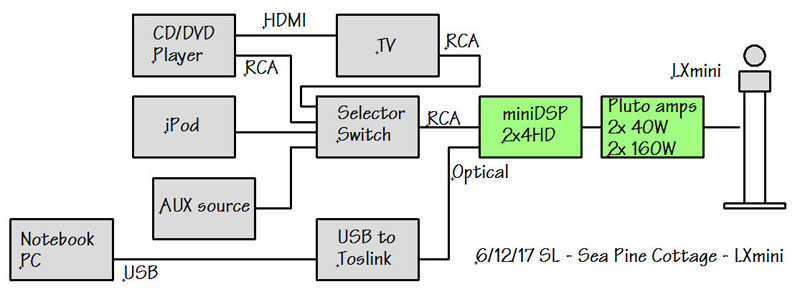
|
--------------------------------------------------
I am done and happy ----------------------------------------------------------
December,
2013
Upgrading the LX521.4
electronics
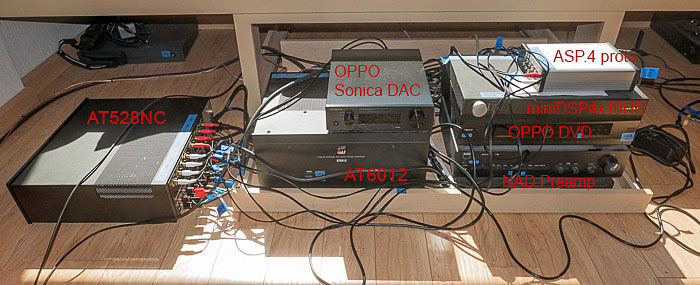
March 2017
- Originally I had been using the LX521 with its 3-way
ASP and AT6012. But then I converted the system to 4-way digital with
miniDSP4x10HD
.
- For several years now, I have been using 10 channels of
an AT6012, 12x60W, power amplifier to drive the LX521.4. The input signals
to the AT6012 come from a miniDSP 4x10HD digital signal processor. It is
driven from my notebook PC's USB output via a miniDSP USB streamer's
conversion to optical input for the 4x10HD.
- My first step now was to replace the AT6012
with the AT528NC,
8x200W, power amplifier. The difference was audible within seconds - and
independent of volume level - as greatly increased clarity, darker bass and
fine spatial imaging detail. This change is a "no-brainer". The
AT528NC is absolutely going to stay.
What surprised me, was that I now hear a sound, which is very similar to my
memory of the PowerBox 6pro NCore at my place in
- Madera. And that with
the miniDSP 4x10HD in the signal chain! Sometime I will have to set up a
direct comparison in CM.
- The next step was to replace the miniDSP
4x10HD with the OPPO Sonica
DAC and ASP.4
prototype. The DAC is driven directly via USB from my PC. I had tried this
setup in Corte Madera. It sounded less transparent compared to the PowerBox
6pro system and with the edges more rounded, less black and more brown, but
pleasant in its own way. My friend, JV, a professional in audio production
came for a listen and using just a minute of one of his orchestral
recordings, immediately found the ASP.4 quite different from the PowerBox:
less open, grainy and maybe compressing. He could not live with it. The
Sonica DAC is not likely the culprit, because we both heard an earlier OPPO
HA-1 DAC driving the Kii
3 speakers to astounding clarity and smoothness.
But here in Sea Ranch it was about comparing the ASP.4 + Sonica DAC to the
miniDSP 4x10HD. That became a repeat of my experience in CM, with the ASP.4
having less clarity, less imaging precision and black, but more brown.
My neighbor here, NP, a seasoned Class A amplifier designer, who listens at
much lower volume levels than I prefer, summed it up: "Give me one of
these and one of those a customer might say". But we both believe that analog should be at
least as accurate as digital. So tomorrow we will get together in his
workshop to perform a
bunch of electrical tests on the ASP.4 to identify a reason for the sonic
difference, which we hear.
- We were successful and identified an immediate problem
and several potential problems. The immediate problem was a defective +/-12V
power supply, which put a noisy 180 Hz modulation at very low level on
signals in tweeter, upper-mid, lower-mid and woofer channels. This explains
why the OPA2134 loaded pcb sounded too warm and was improved by loading it
with LM4562's, which have higher supply rejection. A change of power supply
resolved the issue.
.
Next we checked at specific frequencies the total harmonic distortion plus
noise output versus input signal level. The tweeter channel clips at 10 kHz
with 6.5 V input, which corresponds to 6 V output, or 17 Vpp. No problems
here.
The Upper Midrange channel measurement at 3 kHz and higher frequencies is
shown below. Clipping is at 2.7 V in, corresponding to 1.3 V out due to the
frequency response attenuation. Further investigation is need in particular
because peak and dip filters have very large resonance voltages, which at
5.4 kHz and 9 kHz lead to internal circuitry clipping. A circuit change is
needed, which does not degrade noise performance significantly. Presently,
noise is not audible.
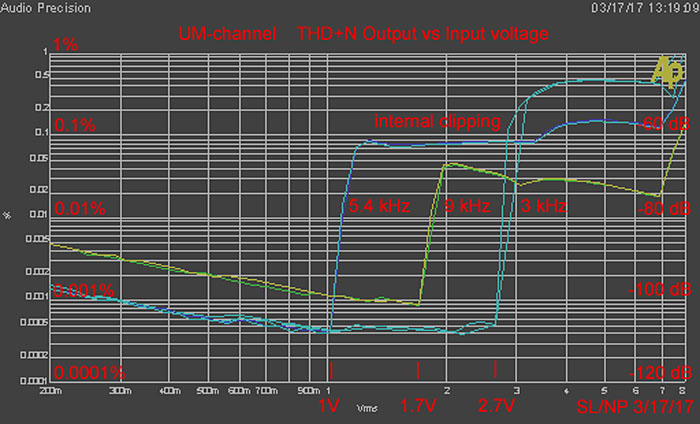
The Lower Mid channel, at 150 Hz, clips at 5 V in with 5
V out. Further investigation is needed why the levels are not higher.
The woofer channel, at 50 Hz, clips at 4 V in with 7 V out, which seems
fine.
We found that crosstalk between left and right channels at -40 to -50 dB is
too high. This may be as easy to fix as placing the two pcb next to each
other, rather than on top of each other. Also I am highly suspicious, from
looking at the pcb trace layout, that crosstalk between T, UM, LM and W
sections on the pcb are too high. I will investigate.
- Further work is needed before I am satisfied with an
ASP.4. But I already hear now, with the power supply replaced, a realism
from the Sonica DAC and ASP.4 proto, that I have no hesitation to replace
the miniDSP 4x10HD by that combination. And ultimately I envision an LX521.4
with ASP to be my top design.
- UPDATE, 26 March 2017 - I now have measured the ASP.4
extensively for frequency response in magnitude and phase and compared the
data to the miniDSP 4x10HD target transfer functions. I reduced the gain of
the LM channel by 1 dB, and changed some circuitry in the UM channel to
reduce internal signal levels, thereby increasing already high overload
margins. I have measured 2-tone intermodulation distortion in each band and
within internal circuitry. I tested for crosstalk between L and R channels
and for crosstalk from T, LM and W channels into the UM channel. It all is
extremely low. No spurious MHz oscillations detected. Noise is inaudible. I
know of nothing to change at this point, which might increase audible
performance. The revised circuit diagram is part of the LX521 owner support
documentation.
Compared to the PowerBox 6pro NCore I sometimes hear subtle differences. But
I cannot say which component in the signal chain causes them since I use a
completely different front end and power amplifiers for the LX521.4 with
ASP.4. Maybe I will track it down eventually and thereby add to my
understanding of sonic modifiers. I will certainly enjoy my new system in
Sea Ranch.
- Why do I want an ASP.4? Because it
would make the LX521.4 a self-contained product, which I can optimize in the
analog world that I am most familiar with. But as all my listening these
days is to digital sources I cannot get around the influence of a DAC upon
what I hear. At this point the PowerBox 6pro NCore with its DLCP and DACs
and driven from USB via afi reclocker has a touch of engagement, which is
missing from the Sonica DAC and ASP.4 combination, although its presentation
is eminently smooth and just as dynamic. No differences in timbre or
frequency extension. I am hoping to get other listener's impressions during
the upcoming Open House.
- Hurrah! I found the weak spot. It takes the artistic-fidelity
isolator & USB Module in front of the Oppo Sonica DAC to bring the
ASP.4 plus AT528NC based system to the level where I can totally enjoy it
and become deeply engaged emotionally.
The ASP.4 is not limiting the sonic performance of the LX521.4!
Transfer of audio data from laptop to DAC and performance of the DAC are the
critical elements for the ASP.4 plus AT528NC analog system.
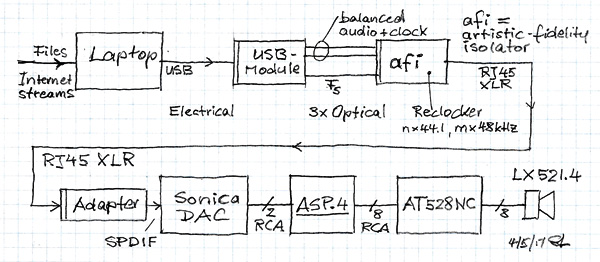
==============================================================
In our vacation home on the Pacific Coast of Northern California I
have set up both, the LX521 and the PLUTO, loudspeaker systems.
Our new "Vista Room" with a sweeping view towards the ocean is also a
great music room day or night. The TV screen sits on a rolling cart and can be
moved between the speakers for watching movies from a large L-shaped sofa/queen
bed. Four steps lead into the room behind the sofa, coming from the hallway to
the right of the photo. Thus the wall at 50" (1.25 m) behind the
listener is not as far removed as I would have wanted. We had to stay within
building restrictions. But I am very satisfied with the sound. It has an
intimate feeling.
As source for various disc formats I use the Oppo BDP-95.
I bring a WD 1 TB hard drive with more music files from home. My Nexus 4 phone
with a "TuneIn Radio" app provides Internet radio stations. A NAD
preamp sets the volume and a AT6012 provides amplification.
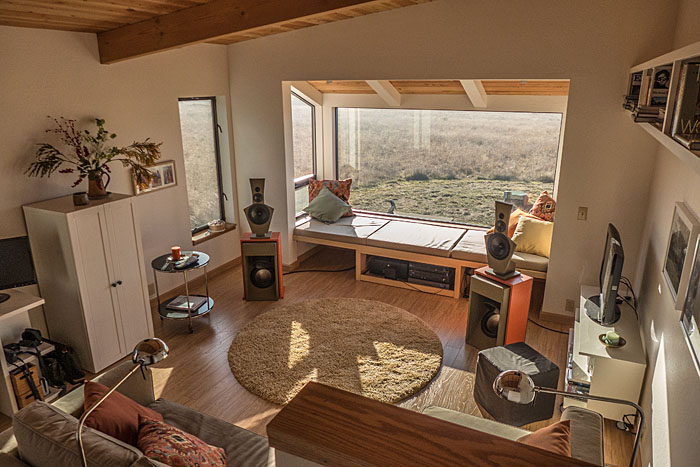
PLUTO resides in a separate living area, which is open to
the dining area on the left and the kitchen behind the viewer. For optimum
imaging performance the speakers can be pulled forward, but this is rarely done.
Audio input to the system is from a CD/DVD player, iPod, audio and video
cassette tape players (!) or TV.
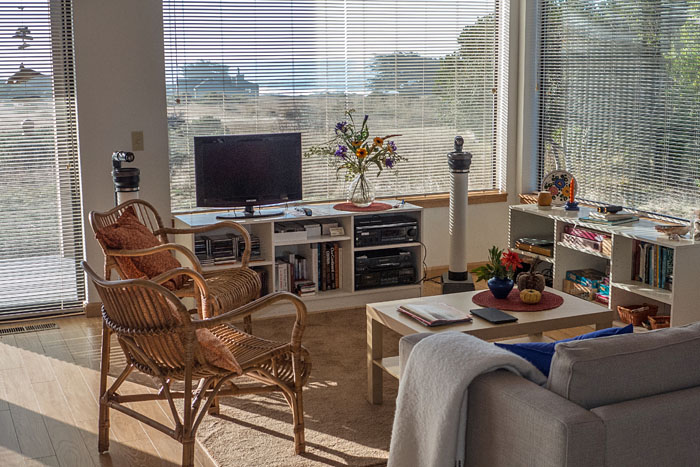
===================================================
Past setups in vacation cottages on the
coast
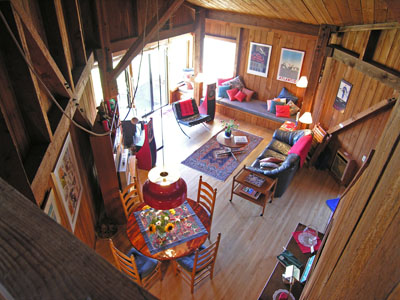
View from the sleeping loft into the living room
of "Honeymoon Cottage" at The Sea Ranch, CA, on the Pacific
Coast.
|
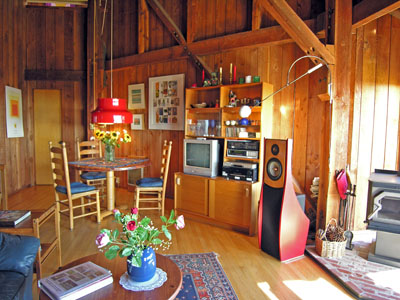
Living room of HMC with ORION loudspeakers.
The cottage was sold in 2010. |
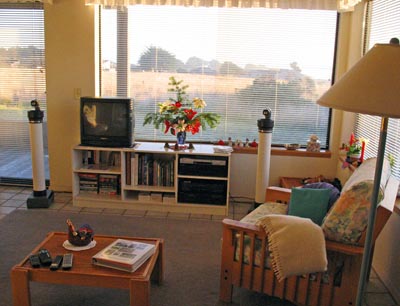
PLUTO loudspeakers in
"Sea Pine Cottage", which is close to the ocean in Sea
Ranch.
The cottage has been remodeled and
enlarged to also accommodate LX521 loudspeakers.
|
|
=================================================================
|